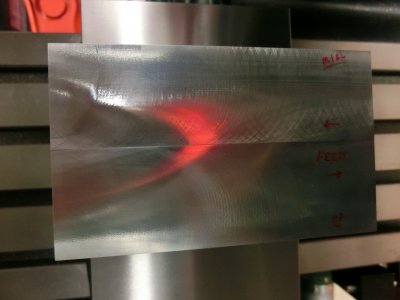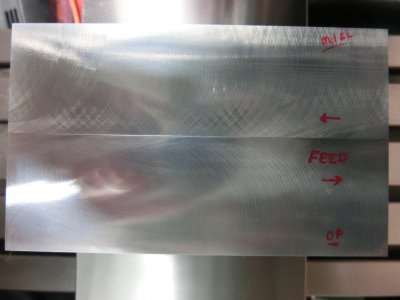- Joined
- May 8, 2015
- Messages
- 86
Suggestions welcome!!
While perusing Craigslist for a machinist vice – I came across an ad for a Grizzly mill that had never been used… apparently a guys father was going to do some gunsmithing work but something changed and the mill and the lathe he had bought sat in his garage for years under a tarp until his recent passing.
It’s a G0484 mill/drill and the metal tag shows a manufacture date of 2009… there was cosmoline coating over just about everything. Tooling he had purchased with it were still in sealed plastic, boxes, etc. The guy offered me nice deal and I thought it a good choice for a first mill - being a complete newbie to this addicting hobby.
After clean-up the first item of business was to tram the thing… which for the yaw was relatively easy as the head does have tilt ability with this model. However the “nod” has been an ordeal and it is still not right. To “adjust” this means loosening the four ¾” bolts that hold the square column to the base, and installing shims..( ie feeler gauges) and tighten everything back down and retest….again and again and again… A Royal PITA!!!
Attached are a couple of photos from the latest attempt. (BTW I’m using Edge technology’s tramming tool and both indicators show the tram is correct, side to side or yaw – and front to back – nod.… but not according to the test cuts!
On the first pass at the top, the table moved from right to left. The second pass at the bottom section from left to right, and the table moved towards the machine, away from the OPerator. You can see the ridge between the two passes - .0015 difference. Also visible are the tooling marks… top is pretty much “crosshatched” (disregard the far left side—I hit the accelerator button on the table feed by accident). On the second pass the trailing edge of the tool left more pronounced markings and no crosshatch is visible. What might this mean? What am I doing wrong?
I’m starting to wonder if this machine just has a warped table or so much “stack tolerance buildup” in it that when the table is moved on the y axis it changes eveything somehow… I feel like I am chasing my tail trying to get this right.
Suggestions folks? (Other than relisting it on ebay and wait until summer to get a far better quality machine.. which I might end up doing anyway!) Also – I live in Sparks NV at 4,700 altitude and it’s like 30 degees now in the garage at night. The garage is heated to 60 degrees in about an hour before I work in my little “shop”… but maybe it takes longer for the machine to get to a higher temp? Just how sensitive are machines to 30 degree temperature changes?


While perusing Craigslist for a machinist vice – I came across an ad for a Grizzly mill that had never been used… apparently a guys father was going to do some gunsmithing work but something changed and the mill and the lathe he had bought sat in his garage for years under a tarp until his recent passing.
It’s a G0484 mill/drill and the metal tag shows a manufacture date of 2009… there was cosmoline coating over just about everything. Tooling he had purchased with it were still in sealed plastic, boxes, etc. The guy offered me nice deal and I thought it a good choice for a first mill - being a complete newbie to this addicting hobby.
After clean-up the first item of business was to tram the thing… which for the yaw was relatively easy as the head does have tilt ability with this model. However the “nod” has been an ordeal and it is still not right. To “adjust” this means loosening the four ¾” bolts that hold the square column to the base, and installing shims..( ie feeler gauges) and tighten everything back down and retest….again and again and again… A Royal PITA!!!
Attached are a couple of photos from the latest attempt. (BTW I’m using Edge technology’s tramming tool and both indicators show the tram is correct, side to side or yaw – and front to back – nod.… but not according to the test cuts!
On the first pass at the top, the table moved from right to left. The second pass at the bottom section from left to right, and the table moved towards the machine, away from the OPerator. You can see the ridge between the two passes - .0015 difference. Also visible are the tooling marks… top is pretty much “crosshatched” (disregard the far left side—I hit the accelerator button on the table feed by accident). On the second pass the trailing edge of the tool left more pronounced markings and no crosshatch is visible. What might this mean? What am I doing wrong?
I’m starting to wonder if this machine just has a warped table or so much “stack tolerance buildup” in it that when the table is moved on the y axis it changes eveything somehow… I feel like I am chasing my tail trying to get this right.
Suggestions folks? (Other than relisting it on ebay and wait until summer to get a far better quality machine.. which I might end up doing anyway!) Also – I live in Sparks NV at 4,700 altitude and it’s like 30 degees now in the garage at night. The garage is heated to 60 degrees in about an hour before I work in my little “shop”… but maybe it takes longer for the machine to get to a higher temp? Just how sensitive are machines to 30 degree temperature changes?



